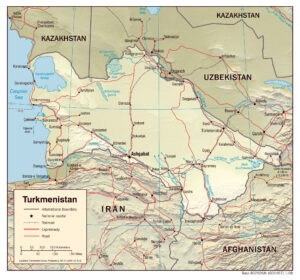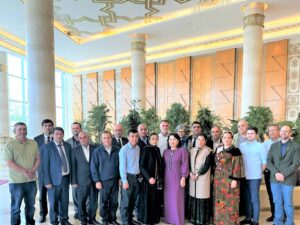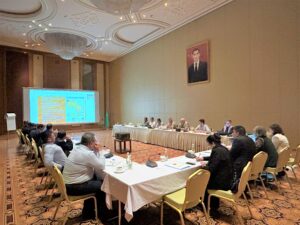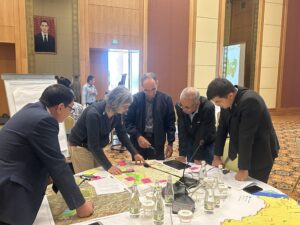 Located in southeast Turkmenistan, on the border with Uzbekistan and close to Afghanistan, the Mountain Ecosystems of Koytendag (MEK) are one of the most distinctive landscapes in Central Asia. The region extends from the hot, dry, semi-desert plains of the Amu Darya River Valley to the snow-capped peaks of Ayrybaba, rising to 3,137 meters (10,292 feet) as the highest mountain in Turkmenistan. Covering a combined area of over 100,000 hectares, the ecosystem hosts rare species such as Urial sheep, lynx, and markhor, and is important habitat for pistachio and juniper forests. Recently, experts from this area and around the country gathered to discuss how to conserve this extraordinary natural area, including how to ensure its habitat areas remain connected.
Located in southeast Turkmenistan, on the border with Uzbekistan and close to Afghanistan, the Mountain Ecosystems of Koytendag (MEK) are one of the most distinctive landscapes in Central Asia. The region extends from the hot, dry, semi-desert plains of the Amu Darya River Valley to the snow-capped peaks of Ayrybaba, rising to 3,137 meters (10,292 feet) as the highest mountain in Turkmenistan. Covering a combined area of over 100,000 hectares, the ecosystem hosts rare species such as Urial sheep, lynx, and markhor, and is important habitat for pistachio and juniper forests. Recently, experts from this area and around the country gathered to discuss how to conserve this extraordinary natural area, including how to ensure its habitat areas remain connected.

To enhance efforts that better conserve and connect these places and species, multiple activities have been undertaken by the Center for Large Landscape Conservation’s team in Turkmenistan between 2021 and early 2023, with a main objective of supporting the inscription of MEK as a UNESCO Natural World Heritage Site. Over the course of our project Connectivity, Capacity, and Cats: Building Resiliency in the Mountain Ecosystems of Koytendag, supported by the Critical Ecosystem Partnership Fund (CEPF), the team’s visits have contributed toward better understanding the ecosystem in Koytendag State Nature Reserve (SNR) and adjoining wildlife sanctuaries. This has included enhancing capacities for surveying, monitoring, and enforcement within and around the Reserve and four Wildlife Sanctuaries – Garlyk, Hojaburjybelent, Hojagaravul, and Hojeypil. After the most recent field mission with national and international experts, recommendations have coalesced for reducing the threats to the reserve’s biodiversity and landscape integrity. These include dealing with the expansion of agriculture and livestock rearing contributing to habitat loss, as well as illegal hunting and potential human-wildlife conflict.

A further project milestone was reached on 17-18 April 2023 at the “Connectivity Conservation Workshop – Ecological Networks for Koytendag State Nature Reserve (SNR)” in the capital city of Ashgabat, Turkmenistan. With 30 participants, this meeting drew together expertise and new information to enhance capacities, address threats, and build collaboration for more consistent conservation across the landscape. To support further practical solutions, the Center worked with staff from protected areas, agencies, ministries, and related conservation associations to engage in a connectivity planning exercise supported by field data, practitioner expertise, and the IUCN Guidelines for ecological corridors in the context of ecological networks. Together, participants considered effective actions for Koytendag SNR, Koytendag-Hissar Corridor, and possible applications in other parts of Turkmenistan.
Specific objectives of the workshop included:
- Sharing information and experiences about land and species management across landscapes in Turkmenistan;
- Presenting available, spatially explicit ecological data and research results about focal species (urial, lynx, and markhor) and habitats around Koytendag SNR;
- Use of Koytendag SNR as a case study to apply, test, and advance knowledge about the reserve and the connectivity of the wider landscape and its wildlife; and
- Demonstration and capacity-building for participants to determine opportunities for enhancing the design, governance, and management of ecological corridors and networks in Turkmenistan.

On the first day of the workshop, opening remarks were provided by Mr. Jumamurad Saparmuradov, Head of the Environment Protection and Hydrometeorology Division, Ministry of Agriculture and Environment Protection (MAEPT) of Turkmenistan welcoming national and international experts and thanking all for their efforts to conserve the country’s nature. Ms. Chinar Rustamova, Director of the Turkmenistan National Commission for UNESCO then added her greetings and emphasized the project’s important contributions toward preparing an updated dossier to advance Koytendag SNR’s consideration for status as a UNESCO Natural World Heritage Site. Ms. Shirin Karryeva, CEPF Project Coordinator in Turkmenistan, concluded by thanking everyone for their presence and wishing all a successful workshop. Thereafter, presentations from experts provided insights into the important biodiversity of Koytendag SNR, including the newest field research and applicable national and international policies that can support its conservation. To close the first day, CEPF project staff and contributing experts received their certificates for completing their SMART (Spatial Monitoring and Reporting Tool) training.

The second day was devoted to applying the Center for Large Landscape Conservation-led ecological corridor and network planning approach. Over the course of multiple breakout and full group meetings, participants discussed and accumulated input about specific connectivity values around the reserve, and recorded potential actions for the design, governance, and management of specific areas. The meeting concluded with outlining shared visions and preliminary plans for seven areas important for connectivity in and around the Koytendag SNR.
A full summary of the workshop was published in English and Russian, providing more details about the outcomes, and to support management agencies, policy-makers, and the wider conservation community in Turkmenistan.
The Critical Ecosystem Partnership Fund is a joint initiative of l’Agence Française de Développement, Conservation International, the European Union, the Global Environment Facility, the Government of Japan and the World Bank. A fundamental goal is to ensure civil society is engaged in biodiversity conservation.
Top photo: Wild tulip, Koytendag State Nature Reserve, Turkmenistan (Courtesy: Khodjamurad



